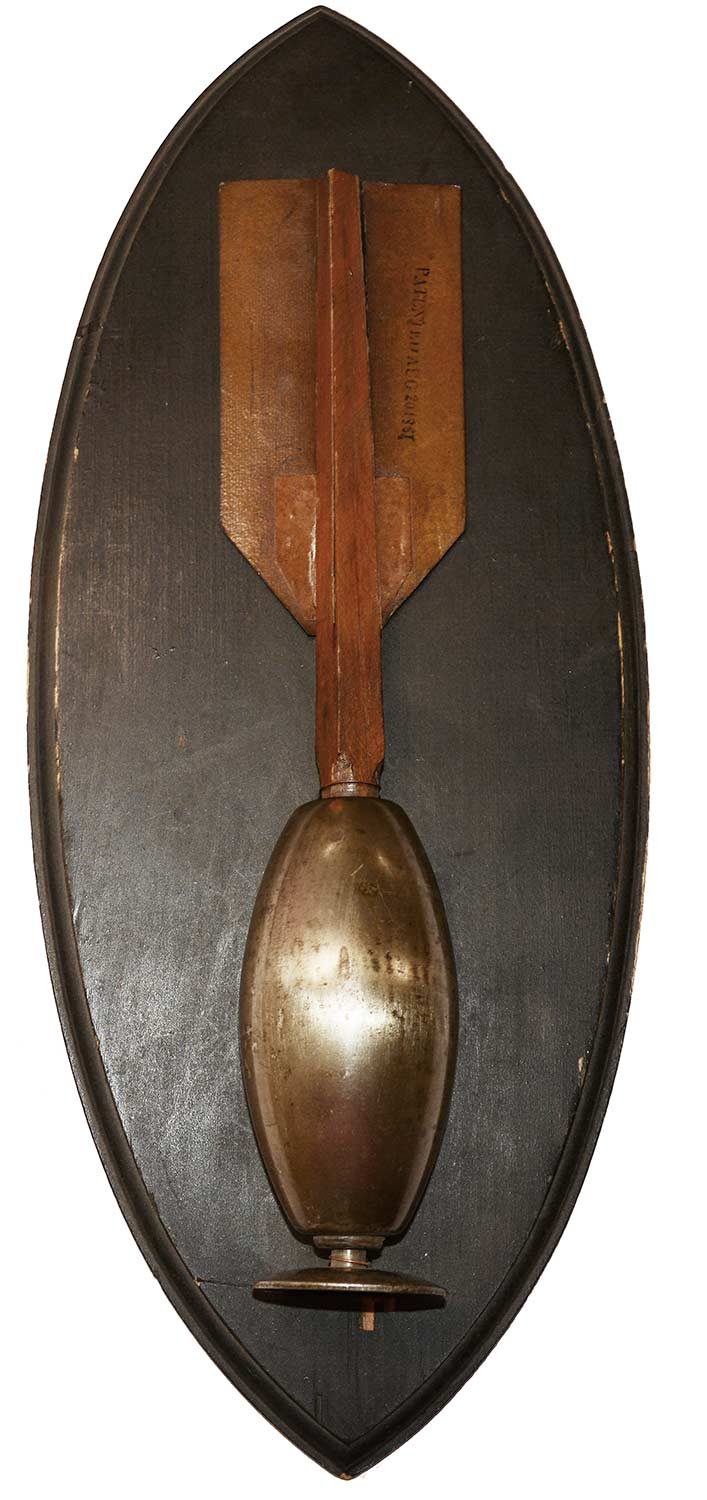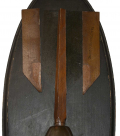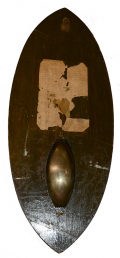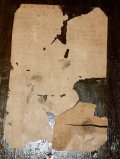site search
online catalog
3 LB KETCHUM GRENADE MOUNTED ON WOOD BY BANNERMAN

$850.00 SOLD
Quantity Available: None
Item Code: 480-296
This 3-lb Ketchum grenade is in nice condition. The body and plunger are very clean. Wood shaft is complete but only two of the three fins are present and these are loose. Both fins are original and one is marked “PATENTED AUG 20 1861.”
The grenade has been mounted to a oval piece of wood with a routered border and painted black. Border meas. approx. 7.50 x 18.50 inches. Wood is in good condition with minor surface chips along the edges.
The back of the piece has a badly worn typed paper label describing the use and arming of the grenade. Some of the type has faded and in other areas small amounts of the label are missing.
Findagrave.com offers a succinct biography of Bannerman as follows:
“Francis Bannerman VI was a merchant and antiquarian. Born in Dundee, Scotland on 24 March 1851. Bannerman emigrated with his family to America in 1854. The family name is a given name, allegedly by none other than King Robert Bruce to a Francis of clan Macdonald upon his rescuing the clan pennant during the battle of Bannockburn. The king supposedly cut off a streamer from the national St. Andrew's Cross and proclaimed that first Francis a "Bannerman."
Francis VI made a business of purchasing surplus military goods in large lots and splitting into smaller lots at a profit. He is sometimes credited with originating the concept of the sealed bid. At the close to the Spanish-American War, Bannerman secured 90% of the captured weapons and goods. At the outbreak of World War I he outfitted British regiments at his own expense long before the United States entered the war. Upon the U.S. entering the fray, he donated significant hardware to its efforts.
Bannerman's store fronts at 579 Broadway, New York and later at 501 Broadway, New York gained recognition as de facto museums of military history. When the city of Brooklyn declined his efforts to expand his warehouse within its borders, he purchased Pollepel Island in the Hudson River, about 40 miles north of Manhattan, and built a series of interconnected warehouses patterned after Scottish baronial castles. The ruins of Bannerman's castle still stand. Even today Bannerman's large, illustrated (and out-of-print) catalogs serve as reference guides for collectors of antique military hardware. Many believe these the best books published on weapons of war.
The one-time largest dealer in military surplus, Bannerman's often stated goal was that his stock become obsolete as humanity learned to settle disputes through other means, and that his vast collections become a museum to the "lost arts." [ad] [ph:L]
~~~~~~~~~~~~~~~~~~~~~~~~~~~~~~~~~~~
THIS ITEM, AS WITH ALL OTHER ITEMS AVAILABLE ON OUR WEB SITE,
MAY BE PURCHASED THROUGH OUR LAYAWAY PROGRAM.
CLICK HERE FOR OUR POLICIES AND TERMS.
THANK YOU!
Inquire About 3 LB KETCHUM GRENADE MOUNTED ON WOOD BY BANNERMAN
For inquiries, please email us at [email protected]
Most Popular
Historical Firearms Stolen From The National Civil War Museum In Harrisburg, Pa »
Theft From Gravesite Of Gen. John Reynolds »
Selection Of Unframed Prints By Don Troiani »
Fine Condition Brass Infantry Bugle Insignia »
British Imported, Confederate Used Bayonet »
Piece Of Wood From The Room In The White House Where Lincoln Signed The Emancipation Proclamation »
featured item
CAPTURED CONFEDERATE SECOND NATIONAL FLAG, UNUSUAL VARIATION WITH MADAUS LETTER, FROM A SOLDIER IN THE 59th NEW YORK
This 2nd National Confederate Flag was purchased in the 1980s by a well-respected Florida dealer/collector directly from descendants of the Union soldier who had kept it as a trophy. It comes with a 1988 letter on Milwaukee Public Museum letterhead… (1179-019). Learn More »
site search
Upcoming Events
The shop will remain closed to the public through Friday, Jan. 31st, re-opening on Saturday, Feb.… Learn More »











